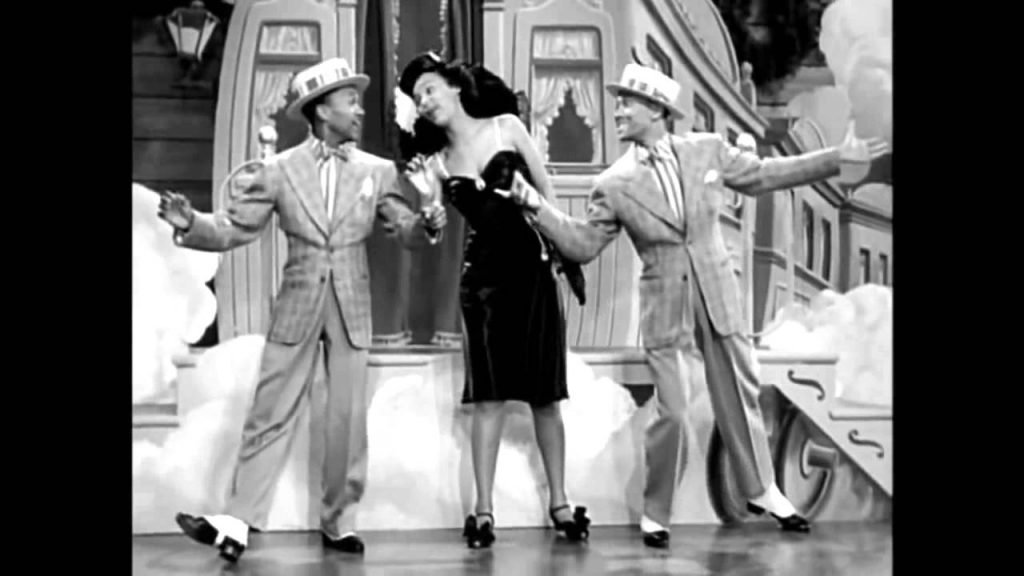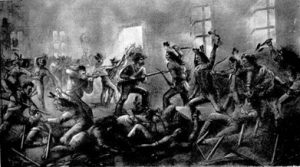It’s the evening of March 30, 1955. It’s the night of the 27th Academy Awards in Hollywood California. The celebrities are arriving in their limousines, and emerging from one of these, herded with blinding flashing lights, is a star. This star, from Cleveland, Ohio, is living out her dream. She has been nominated for the Best Actress award. Tonight, she’s making history. This woman is Dorothy Dandridge, and just for her being nominated, she is making history. Dorothy is the first African-American woman ever to be nominated for this award. And this nomination changed the way Americans thought, at least for that night. That Oscar would look so befitting in her hands. Her photo holding that Oscar from that night would be on every cover of every magazine in the country by the morning. Unfortunately, we never got to see that photo, because Dorothy did not win that night.

Dorothy Dandridge, born on November 9, 1922, first began her start in show business with her sister and another young woman in a musical trio. Once they gathered enough attention, they began performing at the Cotton Club during the 1930s.1 The famed Cotton Club was the dance club based in Harlem, New York where the most popular black singers and dancers performed, such as Cab Calloway and Duke Ellington, and it was where Dorothy Dandridge met her future husband. Here, Dorothy and her trio became so popular that they decided to take their show on tour to England. She finally married her husband, Harold Nicholas, of the Nicholas Brothers. The Nicholas Brothers were a duet who sang and tap danced together. Dorothy and Harold married on September 6, 1942. Dorothy’s marriage to Harold, however, was an unhealthy one, because her trio was receiving more fame than the Harold Brothers, causing tensions between them, and because Harold was also having affairs. But shortly after her marriage, Dorothy became pregnant and gave birth on September 2, 1943, and her baby girl was born brain damaged, due to a lack of oxygen. For the best for the child, Dorothy put her daughter in a private care agency. And after a number of years struggling with Harold and his infidelity, she finally divorced him in 1949.2
Determined to get back on her feet following the divorce, Dorothy decided to begin a solo career as a singer. It is as a singer that she gathered many fans and attention. But Dorothy always had a strong interest in acting. In 1948, when things in her marriage were rocky, she enrolled in The Actor’s Lab, which was the prestigious training school for actors in Los Angeles, California. During the 1940s, The Actor’s Lab trained many future Hollywood stars, including Marilyn Monroe. But during this period in cinematic history, it was hard for a black person to get leading roles on the big screen, especially roles that would change how black people were seen in society in general. In spite of her training at The Actor’s Lab, Dorothy would not get the opportunity to play black characters with strong, complex roles.3
As a black woman at this time in American history, if one wanted to act, one would not be given intelligent or self-respecting roles. The roles black women were given were highly stereotypical, but if acting was ones dream, as it was for Dorothy, she would take those stock roles anyway. After leaving The Actor’s Lab, Dorothy became one of those women who was offered those stock, degrading roles. Her first roles were those that had always been derogatory for black women, such as playing the role of a mistress.4 Such was the case in her films Tamango and Island in the Sun. Those roles were certainly easy for a black woman to portray. And Dorothy would receive roles like this until, finally, she landed a role alongside Harry Belafonte. Dorothy became the lead actress in the 1953 film Bright Road, in which she portrays a school teacher helping the principal, Harry Belafonte, tame their problem students. Her role in the film became a success, and it put Dorothy on the map, and brought her acclaim as an actress. But Dorothy wanted a bigger role. She sought out the lead role as Carmen in the 1954 film Carmen Jones. It was hard for black women to receive self-respecting roles in films, but ironically, in order to get such roles, one must first put on the act of not being self-respecting.5

At first, Dorothy was declined the role of Carmen Jones, and it was only after walking into the audition appearing promiscuous that she was given the role. Carmen Jones is a Broadway musical, but it was turned into a musical film starring an all-black cast, with the likes of Harry Belafonte and Pearl Bailey, and directed by Otto Preminger. Known for bringing any character she portrayed to life with her beauty, charisma, and flirtatious style, the role of Carmen Jones solidified Dorothy’s nomination. Shortly, after getting the role, she was put on the cover of Life Magazine in the same attire she auditioned in. Here Dorothy made history. Dorothy became the first African-American woman to grace the cover of Life. This role also got Dorothy Dandridge an Oscar nomination, becoming the first African-American woman nominated for the Best Actress Award. In 1955, it was hard for a black woman, or black man, to get the respect they deserved from the elite Academy of Motion Picture Arts and Sciences, much less be nominated for one of the most prestigious awards any actor can receive. This nomination was important not only for Dorothy, but for the millions of black men and boys, women and girls, who had the opportunity of watching history unfold, and being given a sense of hope and belief in themselves that they may not have had before those awards began.6
That night was important for America, for the black community, and for Dorothy, even though she did not win. She held her own going against some of the most iconic figures in film that night. The other nominees for the award were Judy Garland, Audrey Hepburn, Jane Wyman, and Grace Kelly. Grace Kelly was the winner of the award for her performance in The Country Girl.7

In Hollywood in 1955, Dorothy Dandridge was a double threat: she was a woman and she was black. Because of this, many opportunities passed her by. She was quoted as saying, “If I were Betty Grable, I could capture the world.” Betty Grable was an American singer, dancer, and actress prominent throughout the 1930s and 1940s. This much was true. Dorothy had much to offer, and it seems absurd today that such a minuscule thing such as race could keep someone from practicing their dream, but this is just what kept Dorothy and others’ dreams undermined. Unlike many, Dorothy Dandridge tackled this arbitrary system of discrimination head on, and she became a star. But she was not allowed to shine as brightly as many of her colleagues.8


After her nomination, Dorothy signed a contract with Twentieth Century Fox, entitling her to three more films. She was established as one of the biggest stars of the time. Unfortunately, Dorothy’s last role was in Preminger’s musical Porgy and Bess. On September 8, 1965 a star had truly fallen. Dorothy’s deceased body was found in her apartment. Decades later she would be reincarnated by Halle Berry in the film Introducing Dorothy Dandridge.9

Plagued by the segregation, sexism, and racism of the times, Dorothy Dandridge could not handle it and succumbed to demise. Hollywood throughout the forties and to the sixties reflected America and its racial tensions. Given the racial inequities of the era, Hollywood was not ready to have many leading roles for black women, and this showed through Dorothy’s career. Dorothy Dandridge inspired many, especially after her death. She broke many barriers for aspiring young black actors internationally. She had a dream, but because of her pigmentation, she was treated differently. Despite these odds, Dorothy was a still a formidable and respected actress. Dorothy was finally noticed as the prolific star she was, by being given an honorary star on the walk of fame on January 18, 1983, in Los Angeles, California.10
- African American Eras: Segregation to Civil Rights Times, 2011, s.v. “Dandridge, Dorothy” (1922–1965). ↵
- Rogers Patrick & Lyndon Stambler, “Overdue notice,” People 48, no. 4 (1997): 89. ↵
- Marguerite H. Rippy, “Exhuming Dorothy Dandridge: the black sex goddess and classic Hollywood cinema,” CineAction, no. 44 (1997): 21. ↵
- Louie Robinson, “The Private World of Dorothy Dandridge,” Ebony 17, no. 8 (1962): 116. ↵
- Cynthia Gorney, “The Fragile Flame of Dorothy Dandridge,” The Washington Post, February 09, 1988. ↵
- Walter Leavy, “The mystery and real-life tragedy of Dorothy Dandridge,” Ebony 49, no. 2 (December 1993): 36. ↵
- Robert K. Lightning, “Dorothy Dandridge: ruminations on black stardom,” CineAction, no. 44 (1997): 31. ↵
- Encyclopaedia Britannica, May 2017, s.v. “Dorothy Dandridge.” ↵
- Erin Anderson, “Dorothy Dandridge: Singer & Actress,” Booklist (2011), 71. ↵
- Ed Guerrero, “Dorothy Dandridge: A Biography,” Cineaste, Vol. 23 Issue 4 (1998): 60. ↵



85 comments
Ryann Cervantes
Nice article. Very good use of the intro and the scenario you painted to fool the audience and capture us. She is definitely a pioneer for women of color and I think it’s interesting how she faced issues of race in Hollywood. Especially because such issues are still seen as going on nowadays in regards to people of diverse backgrounds not being nominated or winning awards for movies.
Tyler Sleeter
Really great article. I had never heard of Dorothy Dandridge before but I found her story quite interesting. It is terrible that she was treated so badly simply because of the color of her skin. She was clearly quite talented and it a shame that she was never recognized by the Academy for her talent. She did a great job of achieving all that Hollywood and America would allow to her achieve at that time in history.
Valeria Hernandez
This article Is fantastic! I enjoyed reading about the life of Dorothy Dandridge. The article had a very interesting and captivating introduction. The use of the images is wonderful as I was able to view the star life timeline through the images. The topic is awesome because it demonstrates the life of a tenacious African American. Congratulation on your nomination it’s a wonderful article.
Christine Sackey
I really enjoyed this article, even more, the second time. It is sad that Dorothy Dandridge did not get the credit she deserved due to racism. Racism can block people from acknowledging other’s talent and that is a shame. Dorothy was very talented and she broke history with being on the front cover of Life magazine. She was very brave considering the type of times that she living in. She is defiantly a true star that was gone too soon.
Justin Garcia
This was a very interesting article. I knew nothing about Dorothy Dandridge before reading this article. This article does a good job of not only discussing her personal struggles but also her professional ones as well. It is also great that she did her best in spite of the hardships she had to endure in her career. I believe she is a role model and actress that should be held to a higher degree than she is currently is. Overall this was a great article.
Osman Rodriguez
Awesome topic and well written article. I had no knowledge of Dorothy Dandridge before reading this article. I like your use of photos and videos to portray Dorothy and for us to get a taste of Dorothy’s talents. It is truly inspiring to see people succeed and break through barriers that actually existed at the time. I enjoyed reading through the article for the most part, but there were times where things seemed a bit repetitive. Overall, amazing article!
Mariah Cavanaugh
Congratulations on your nomination! After reading your article I can see why you received a nomination. You touched on racial tensions that were and still are running through Hollywood. Last year the hashtag #Oscarssowhite was trending due to the academy’s lack of diversity. There is a systematic bias that runs through the entertainment industry and although it is spoken about nothing is done to fix the problem. As of 2017 only 11 black women have been nominated for Best Actress and only one has won the award. Your article shed light onto an ongoing issue that is still pervasive today. Great job!
Crystalrose Quintero
I loved that the intro paragraph really set the scene and also had an initially exciting tone and quickly set the mood of disappointment for what was to come. It was so interesting to see that marriage could be torn by fame and the competitiveness of being in show business. It was sad to read that such a strong female actress was limited because of her race.
Tara Sellers
How did she die? In the article it says that she could not handle the prejudice anymore. Does that mean she killed herself? The article itself was good, but I really liked the photos. The photos help makes the story more real. She helped give hope to many and broke down barriers that had never been broken before. I am very happy that I have read this article.
Luke Willis
Wow. this was a very interesting article. I have never really thought about African Americans in the acting business during that time. Now when I think back to the movies of that time that I have seen I realized that many of the African Americans did play stereotypical roles such as servants, or criminals. It is amazing that as an African American women Dorothy was able to break free finally from the stereotypical roles and able to become a true star in a respected role and I am glad that she was finally recognized for the hard work that she did and for all of the obstacles and trails that she had to overcome.